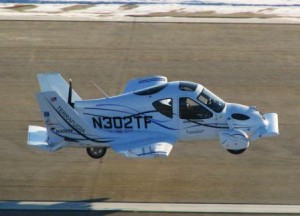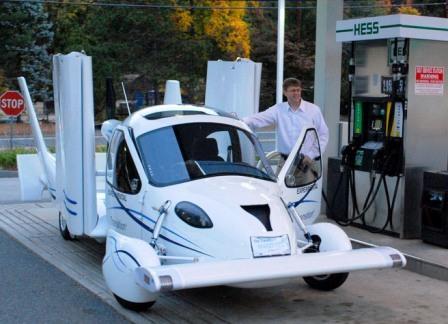
The dream of a flying car persists against all odds.
After six months of testing, a flying car has taken to the air over the runway at Plattsburgh International Airport in New York. The “Transition” light sport aircraft has design goals of 450 miles of cruising flight at speeds up to 115 mph once development, testing and FAA certification are complete — processes that could take years if they are ever accomplished at all.
The unique, proof of concept contraption, four years in the making, has front-wheel drive for road use with a claimed top speed of 60 mph and unspecified “automotive safety” features. A pusher propeller is used for flight. A Federal Aviation Administration Sport Pilot license will be needed to fly it, and even then only in good weather conditions.
Both air and road modes are powered by unleaded gasoline from a regular service station, and the wings fold electronically in just 30 seconds, a feature that is presumably over-ridden when the four wheels are off the ground.
“This breakthrough changes the world of personal mobility. Travel now becomes a hassle-free integrated land-air experience. It’s what aviation enthusiasts have been striving for since 1918,” says Carl Dietrich, CEO of Terrafugia (terra-FOO-gee-ah), a start-up company founded in 2006 by five graduates from the Massachusetts Institute of Technology. (Terra fugia is Latin for escape from land.)
It’s not clear to me what the significance of the 1918 date is. The Wright bothers of course first flew on December 17, 1903 after years of research with kites and gliders that they designed, built, tested and flew.
The Transition test is similar though to the first Wright flight since it was short, very short, less than 30 seconds in duration. The two-seat plane stayed about a wing’s length above the runway for what looked to be 3,000 feet, then quickly landed again. This means that lift was increased from what’s known as “ground effect,” whereby drag is reduced and speed is increased since proximity to the ground reduces wingtip vortices and their consequences.
Whether the Transition has enough power to climb out of ground effect and fly on its own is another matter entirely. This didn’t stop TV news readers from gushing about the project with their usual insight and perspective. The plane — whether it ultimately works or not — will no doubt be a star on the air show circuit since it taps into primeval needs for mobility and whimsy.

The original estimated price of $150,000 has already jumped to $194,000 and this is before the real hard work begins.
Instead of the homebuilt engine of the Wright Flyer, the Transition uses a Rotax 912S engine rated at 100 horsepower. The 4-stroke, 4-cylinder boxer engine is known for its good weight-to-power ratio, but not for anything like automotive durability. Rotax engines have propelled experimental and ultra-light planes, and motor-gliders for quite a while. They also do not come anywhere near to meeting car emission standards.
The original estimated price of $150,000 from the Massachusetts company has already jumped to $194,000; and this is before the real hard work begins. The well documented difficulties of an FAA certification aside, then there’s the mind-boggling complexity of car certification. Let’s start with, oh, impact standards. Airplanes fly in part because they are light and they do this with a structure that is minimal compared to a car’s. Then there’s lighting, fuel system integrity, bumpers, where the license plate mounts — the list goes on and on.
But then so does the dream of a flying car.
